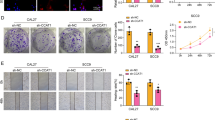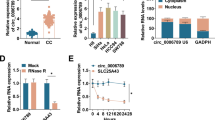Abstract
Circular RNAs have attracted the attention in the research on laryngeal squamous cell carcinoma (LSCC) development. But the function and mechanism of circRNA coronin-1C (circ_CORO1C) in LSCC progression are largely unknown. Circ_CORO1C, microRNA (miR)-654-3p, and ubiquitin-specific protease 7 (USP7) levels in LSCC tissues and cells were determined. Quantitative reverse transcription polymerase chain reaction and western blotting assays were conducted to determine the mRNA and protein levels of genes. Functional assays were further investigated by 3-(4,5-dimethylthiazol-2-yl)-2,5-diphenyl tetrazolium bromide (MTT), EdU staining, flow cytometry, transwell and xenograft assays. The binding relationship was examined by dual-luciferase reporter assay. Circ_CORO1C expression was elevated in LSCC samples and cells. circ_CORO1C silencing constrained cell proliferation and promoted apoptosis via reducing cell proliferation, inducing cell cycle arrest, inhibiting epithelial–mesenchymal transition, and promoting apoptosis, as well as restraining cell migration and invasion. USP7 is highly expressed in LSCC tissues and cells, and its expression was suppressed by circ_CORO1C silencing. Besides, the up-regulation of USP7 attenuated the influence of circ_CORO1C silencing on LSCC cell progression. Both circ_CORO1C and USP7 could bind to miR-654-3p. circ_CORO1C regulated USP7 expression by modulating miR-654-3p. miR-654-3p knockdown mitigated the influence of circ_CORO1C silence on LSCC cell progression. Furthermore, circ_CORO1C silencing reduced tumor growth in vivo. In conclusion, circ_CORO1C is highly expressed in LSCC tissues and cells, and circ_CORO1C silencing repressed LSCC progression via regulating miR-654-3p/USP7 axis.







Similar content being viewed by others
Data Availability
The data used to support the findings of this study are available from the corresponding author upon request.
References
Bonacci T, Emanuele MJ (2020) Dissenting degradation: deubiquitinases in cell cycle and cancer. Semin Cancer Biol 67:145–158
Chu YL (2020) Circ_0067934 correlates with poor prognosis and promotes laryngeal squamous cell cancer progression by sponging miR-1324. Eur Rev Med Pharmacol Sci 24(8):4320–4327
Deng G, Mou T, He J, Chen D, Lv D, Liu H et al (2020a) Circular RNA circRHOBTB3 acts as a sponge for miR-654-3p inhibiting gastric cancer growth. J Exp Clin Cancer Res 39(1):1
Deng L, Meng T, Chen L, Wei W, Wang P (2020b) The role of ubiquitination in tumorigenesis and targeted drug discovery. Signal Transduct Target Ther 5(1):11
Duan M, Fang M, Wang C, Wang H, Li M (2020) LncRNA EMX2OS induces proliferation, invasion and sphere formation of ovarian cancer cells via regulating the miR-654-3p/AKT3/PD-L1 axis. Cancer Manag Res 12:2141–2154
Fan Y, Xia X, Zhu Y, Diao W, Zhu X, Gao Z et al (2018) Circular RNA expression profile in laryngeal squamous cell carcinoma revealed by microarray. Cell Physiol Biochem 50(1):342–352
Geraldo MV, Nakaya HI, Kimura ET (2017) Down-regulation of 14q32-encoded miRNAs and tumor suppressor role for miR-654-3p in papillary thyroid cancer. Oncotarget 8(6):9597–9607
Hayal TB, DoGan A, Sisli HB, Kiratli B, SahIn F (2020) Ubiquitin-specific protease 7 downregulation suppresses breast cancer in vitro. Turk J Biol 44(4):145–157
Lee JE, Park CM, Kim JH (2020) USP7 deubiquitinates and stabilizes EZH2 in prostate cancer cells. Genet Mol Biol 43(2):e20190338
Li P, Liu H, Wang Z, He F, Wang H, Shi Z et al (2016) MicroRNAs in laryngeal cancer: implications for diagnosis, prognosis and therapy. Am J Transl Res 8(5):1935–1944
Li G, Pan C, Sun J, Wan G, Sun J (2020) lncRNA SOX2-OT regulates laryngeal cancer cell proliferation, migration and invasion and induces apoptosis by suppressing miR-654. Exp Ther Med 19(5):3316–3324
Lu C, Shi X, Wang AY, Tao Y, Wang Z, Huang C et al (2018) RNA-Seq profiling of circular RNAs in human laryngeal squamous cell carcinomas. Mol Cancer 17(1):86
Obid R, Redlich M, Tomeh C (2019) The treatment of laryngeal cancer. Oral Maxillofac Surg Clin North Am 31(1):1–11
Panda AC (2018) Circular RNAs act as miRNA sponges. Adv Exp Med Biol 1087:67–79
Pastushenko I, Blanpain C (2019) EMT transition states during tumor progression and metastasis. Trends Cell Biol 29(3):212–226
Pu JT, Hu Z, Zhang DG, Zhang T, He KM, Dai TY (2020) MiR-654-3p suppresses non-small cell lung cancer tumourigenesis by inhibiting PLK4. Onco Targets Ther 13:7997–8008
Steuer CE, El-Deiry M, Parks JR, Higgins KA, Saba NF (2017) An update on larynx cancer. CA Cancer J Clin 67(1):31–50
Thompson LD (2017) Laryngeal dysplasia, squamous cell carcinoma, and variants. Surg Pathol Clin 10(1):15–33
Valles GJ, Bezsonova I, Woodgate R, Ashton NW (2020) USP7 is a master regulator of genome stability. Front Cell Dev Biol 8:717
Varshavsky A (2017) The ubiquitin system, autophagy, and regulated protein degradation. Annu Rev Biochem 86:123–128
Wang Z, Huang C, Zhang A, Lu C, Liu L (2020) Overexpression of circRNA_100290 promotes the progression of laryngeal squamous cell carcinoma through the miR-136-5p/RAP2C axis. Biomed Pharmacother 125:109874
Wu Y, Zhang Y, Zheng X, Dai F, Lu Y, Dai L et al (2020) Circular RNA circCORO1C promotes laryngeal squamous cell carcinoma progression by modulating the let-7c-5p/PBX3 axis. Mol Cancer 19(1):99
Xie P, Wang H, Xie J, Huang Z, Chen S, Cheng X et al (2020) USP7 promotes proliferation of papillary thyroid carcinoma cells through TBX3-mediated p57(KIP2) repression. Mol Cell Endocrinol 518:111037
Xuan L, Qu L, Zhou H, Wang P, Yu H, Wu T et al (2016) Circular RNA: a novel biomarker for progressive laryngeal cancer. Am J Transl Res 8(2):932–939
Yang J, Zhang Z, Chen S, Dou W, Xie R, Gao J (2020) miR-654-3p predicts the prognosis of hepatocellular carcinoma and inhibits the proliferation, migration, and invasion of cancer cells. Cancer Biomark 28(1):73–79
Yu CY, Li TC, Wu YY, Yeh CH, Chiang W, Chuang CY et al (2017) The circular RNA circBIRC6 participates in the molecular circuitry controlling human pluripotency. Nat Commun 8(1):1149
Zhang MJ, Chen DS, Li H, Liu WW, Han GY, Han YF (2019) Clinical significance of USP7 and EZH2 in predicting prognosis of laryngeal squamous cell carcinoma and their possible functional mechanism. Int J Clin Exp Pathol 12(6):2184–2194
Funding
None.
Author information
Authors and Affiliations
Corresponding author
Ethics declarations
Conflict of interest
The authors declare that they have no conflict of interest.
Additional information
Publisher's Note
Springer Nature remains neutral with regard to jurisdictional claims in published maps and institutional affiliations.
Supplementary Information
Below is the link to the electronic supplementary material.
10528_2021_10169_MOESM1_ESM.tif
Figure S1. The effects of miR-654-3p in sh-circ_CORO1C-mediated LSCC cell progression. (A) miR-654-3p expression level, (B and C) USP7 mRNA and protein levels, (D and E) cell cycle progression, (F and G) cell viability, (H and I) proliferation, (I) cell apoptosis, (J and K) migration and invasion, as well as the protein levels of Snail, Twist1 and E-cadherin were determined in TU-177 and FD-LSC-1 cells transfected with sh-NC, sh-circ_CORO1C, sh-circ_CORO1C + anti-miR-NC or anti-miR-654-3p. *P<0.05, **P<0.01, ***P<0.001. Supplementary file1 (TIF 3152 KB)
Rights and permissions
About this article
Cite this article
Zhang, J., Li, H., Li, J. et al. CircRNA CORO1C Regulates miR-654-3p/USP7 Axis to Mediate Laryngeal Squamous Cell Carcinoma Progression. Biochem Genet 60, 1615–1629 (2022). https://doi.org/10.1007/s10528-021-10169-1
Received:
Accepted:
Published:
Issue Date:
DOI: https://doi.org/10.1007/s10528-021-10169-1




